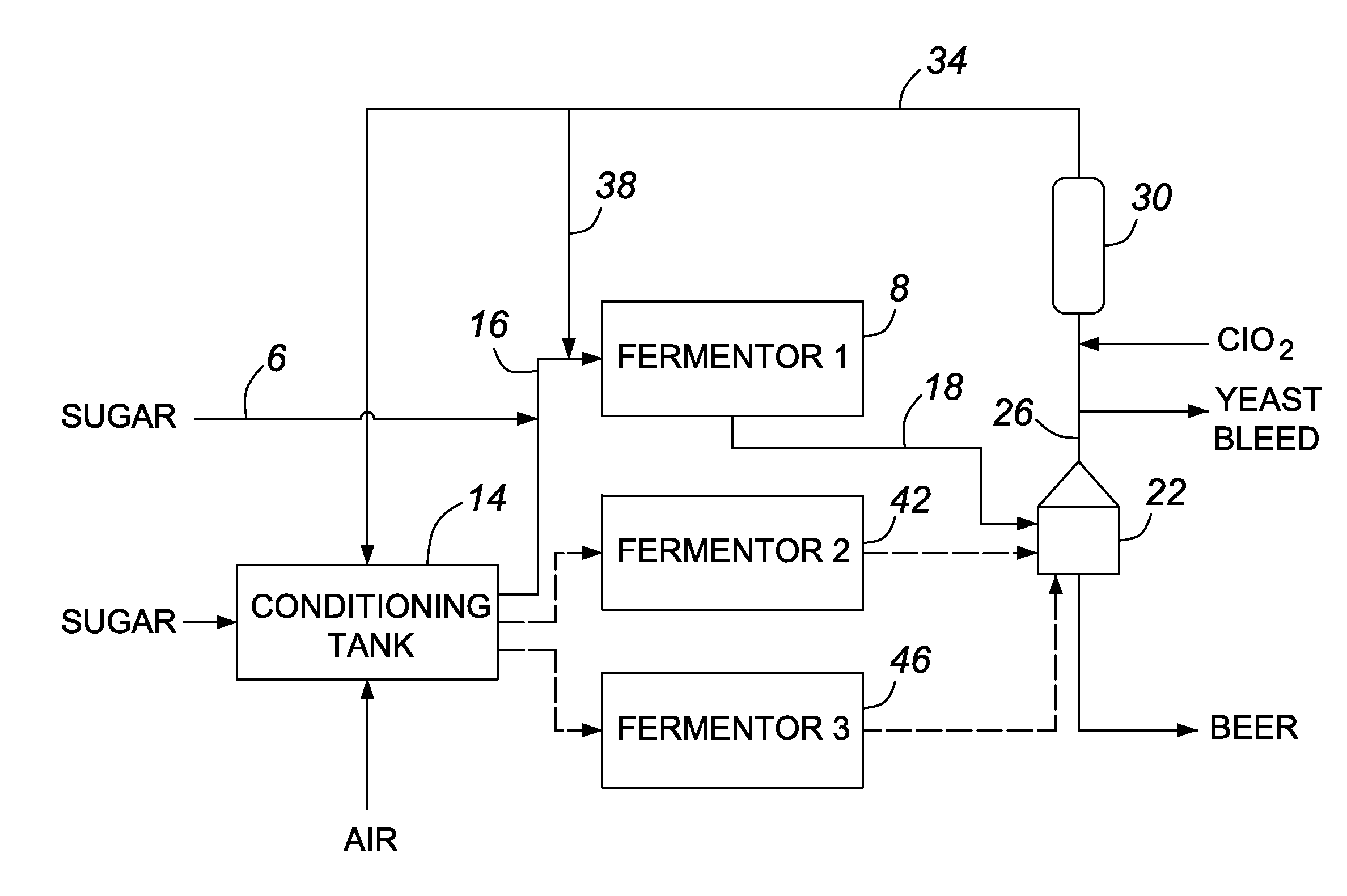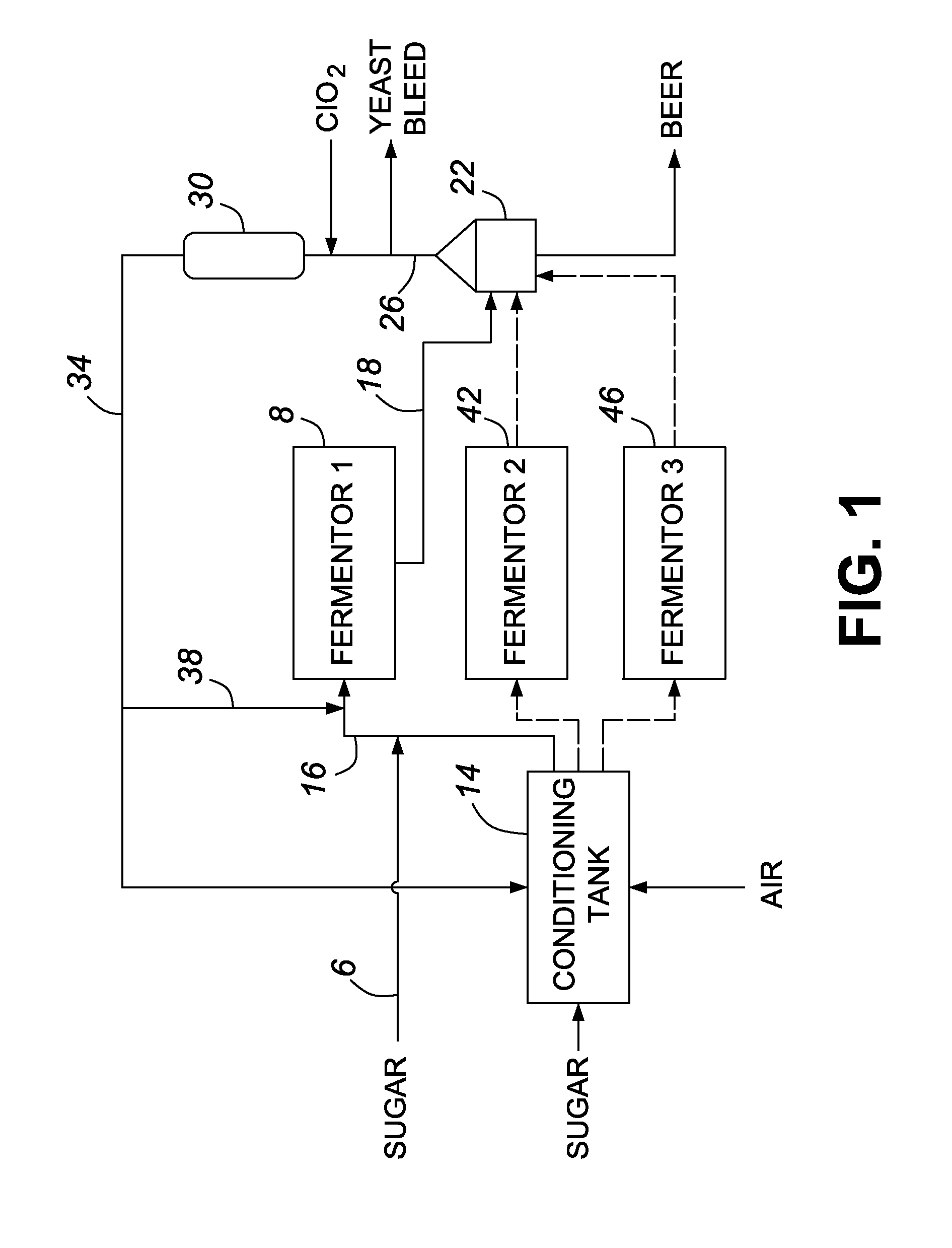Method for the production of a fermentation product from a sugar hydrolysate
a technology of sugar hydrolysate and fermentation product, which is applied in the direction of fermentation, biofuels, etc., can solve the problems of limited conversion of cellulose to glucose, reduced yield of desired fermentation product, and increased production cost, so as to reduce the viability or fermentative capacity of yeast, the yield of desired fermentation product, and the effect of reducing microbial contaminants
- Summary
- Abstract
- Description
- Claims
- Application Information
AI Technical Summary
Benefits of technology
Problems solved by technology
Method used
Image
Examples
example 1
Chlorine Dioxide Treatments of Acidified Yeast Cream: Anti-Bacterial Efficacy and Dose Requirements
example 1.1
Synergistic Anti-Bacterial Effect of Chlorine Dioxide and pH
[0086]Dilute acid pretreated wheat straw was produced on an industrial scale as set forth in U.S. Pat. No. 4,461,648 (incorporated herein by reference) and then hydrolyzed with cellulase enzymes and β-glucosidase to produce a hydrolysate containing sugar derived from the hemicellulose and cellulose components of the feedstock. This hydrolysate was fermented in an industrial fermentation to produce ethanol with a Saccharomyces cerevisiae yeast strain set forth in co-pending and commonly owned, WO 2009 / 026706 (incorporated herein by reference). Yeast recycle was employed during the fermentation.
[0087]A yeast cream (also referred to herein as a “yeast slurry”) separated from the fermentation broth and contaminated with bacteria that proliferated in the industrial fermentation was treated at 20° C. with acid alone, chlorine dioxide alone or a combination of the two. In the acid treated condition, the pH was lowered from 5.0 to ...
example 1.2
Effect of Chlorine Dioxide Dose on Bacterial Contamination of a Yeast Fermentation Culture
[0091]Contaminated yeast cream obtained from the fermentation of Example 1.1 was titrated to pH 2.0 with sulfuric acid, treated with various concentrations of chlorine dioxide (0, 50, 100, 150 and 200 ppm) and plated to determine the bacterial reduction at pH 2.0 as outlined above, with the exception that the temperature of the treatment was 30° C. rather than 20° C. Bacterial populations were enumerated as previously described (Example 1.1). Bacterial populations were also enumerated on a control sample that was not subjected to chlorine dioxide or pH titration.
[0092]FIG. 3 illustrates the results. Errors bars represent the standard deviation of the mean of duplicate experiments, each plated in triplicate. As shown in the figure, a chlorine dioxide dose of 100 ppm at pH 2 and 30° C. reduced contamination in a yeast cream by 102 CFU / mL. Yeast cream treated with 200 ppm chlorine dioxide at 30° C...
PUM
 Login to View More
Login to View More Abstract
Description
Claims
Application Information
 Login to View More
Login to View More - R&D
- Intellectual Property
- Life Sciences
- Materials
- Tech Scout
- Unparalleled Data Quality
- Higher Quality Content
- 60% Fewer Hallucinations
Browse by: Latest US Patents, China's latest patents, Technical Efficacy Thesaurus, Application Domain, Technology Topic, Popular Technical Reports.
© 2025 PatSnap. All rights reserved.Legal|Privacy policy|Modern Slavery Act Transparency Statement|Sitemap|About US| Contact US: help@patsnap.com



